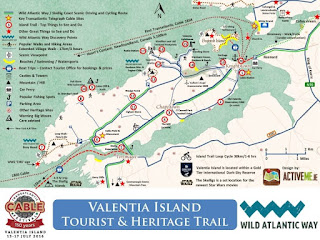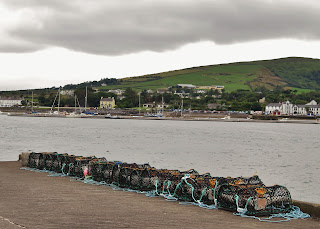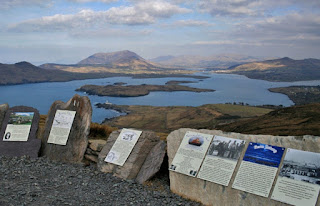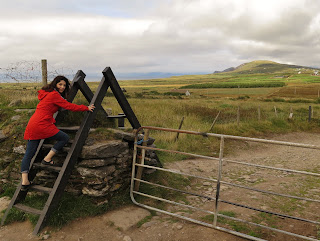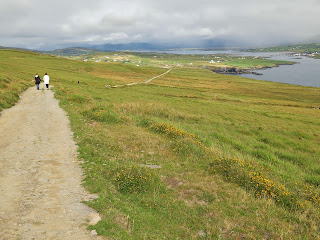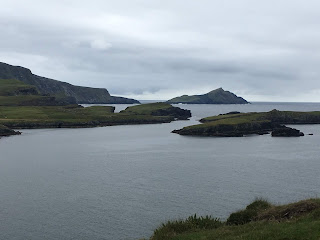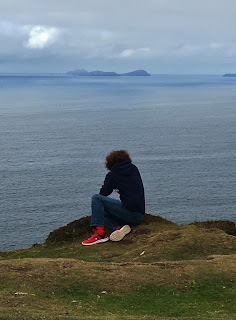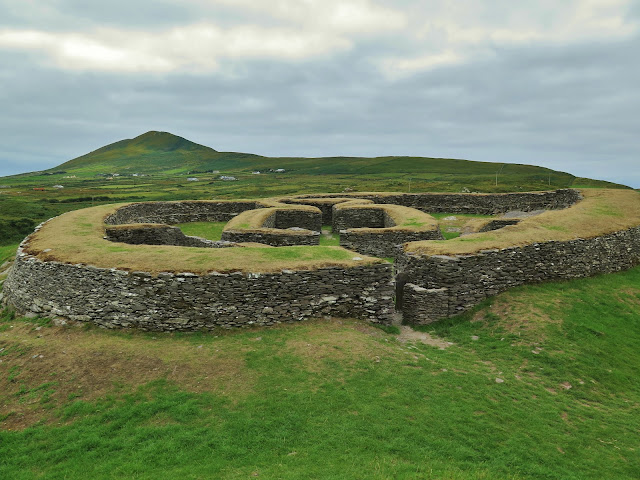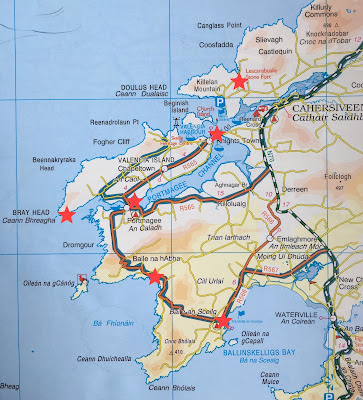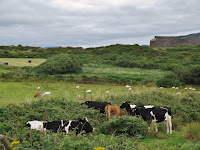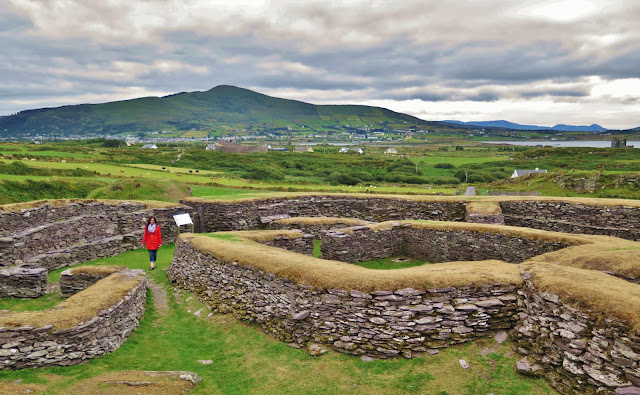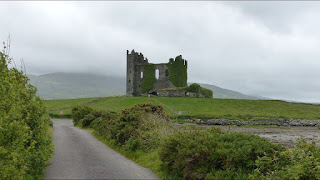There is no other place in the world like Skellig Michael. Isolated. Dramatic. Haunting. A trip to Skellig Micheal is a trip back through time to another world so vastly different that it seems unlikely that it could be real.
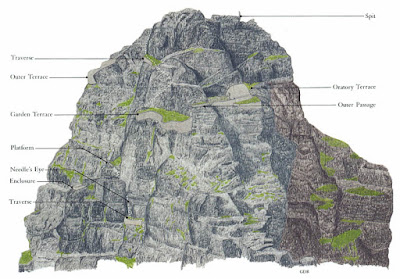 The Skellig Islands (Na Scealaga in Irish) are two islands off the South West Coast of Ireland's County Kerry and the Skellig Ring Road. The islands lie 13 km off the coast, like two remote pyramids floating in the Atlantic Ocean. Skellig Michael, (sometimes referred to as Great Skellig) is the larger of the two Islands and was home to one of Irelands first Celtic Christian monastic settlements. At the same time, Little Skellig is home to an important bird sanctuary. This is why Skellig Michael is one of the two UNESCO World Heritage Sites of Ireland.
The Skellig Islands (Na Scealaga in Irish) are two islands off the South West Coast of Ireland's County Kerry and the Skellig Ring Road. The islands lie 13 km off the coast, like two remote pyramids floating in the Atlantic Ocean. Skellig Michael, (sometimes referred to as Great Skellig) is the larger of the two Islands and was home to one of Irelands first Celtic Christian monastic settlements. At the same time, Little Skellig is home to an important bird sanctuary. This is why Skellig Michael is one of the two UNESCO World Heritage Sites of Ireland.
Getting to Skellig Michael is half of the adventure. Boats leave for Skellig Micheal daily from Portmagee. Because the Skelligs are very fragile, they are protected by UNESCO and are limited to the number of daily visitors allowed on the island. You must have a reservation to go to the Skellig Islands, and they fill up months in advance. Read this TRAVEL GUIDE TO SKELLIG MICHAEL to learn all about getting tickets to the Skelligs.
Even with a reservation, the weather will be the ultimate determiner if you get to see the Skelligs or not.
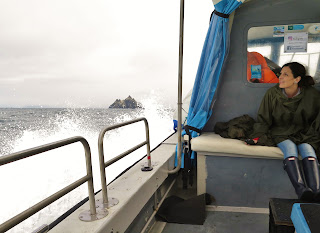 |
| Aboard The Mary Frances |
We donned our rain ponchos the crew members gave us and headed off into the fog on our small boat, the Mary Frances operated by Captain Nealie Lyne. The journey was to take about an hour, and the waves were quite tame. I thought: "no problem" as we sped out into Portmagee Channel, but as soon as we headed out into open water, though, I realized I was having trouble keeping down my Irish oatmeal from breakfast. I just kept staring at the horizon...
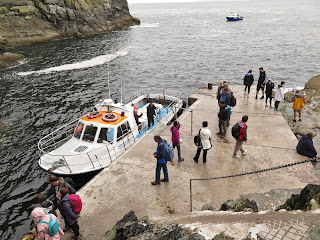 |
| Landing At Blind Man's Cove |
Our excitement quickened when we heard seabirds, and a large triangle appeared in the mist, first one and then the second. My first thought was that these are just the tops of giant mountain peaks poking out of the ocean, and then we saw it-Great Skellig or Sceilig Móhr! We had to wait our turn to land the boat at the one cement pad at the entrance to a sea cave on Skellig Micheal called Blind Mans's Cove. It was really tricky getting off the moving boat, and I could see why many people have a hard time getting off the ship.
Once our group got off the Mary Frances, we walked along a path leading to the lighthouse and the trailhead going up to the monastery. Much of the trail here is covered with a roof because of the danger of falling rock (and it's a sweet relief from worrying about birds pooping on you). At the end of the pathway, a ranger meets you to let you know about the dangers of climbing the 180 meters (600 ft) to the top of Skellig Michael. There have been three deaths on the climb to the top and five serious injuries since 2009, so take extreme care when climbing the 618 steps to the monastery.
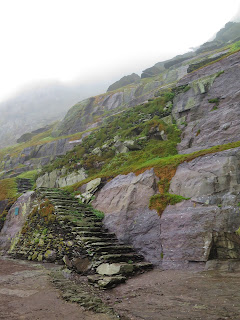 |
| Beginning Of The 618 Steps |
 |
| Rangers House On Skellig Michael |
 |
| Climbing Up Skellig Steps |
The climb up the steps of Skellig Michael was as much a physical journey as a mental and spiritual one. The higher you climb on the hand-carved uneven steps to the monastery, the more you felt like you were ascending backwards through time.
The stairs are steep, and even after a short climb, you are high above the sea and open to the wind gusts that whip around the rocks. There is not much in the way of handrails, and you can't help but think that one false step could send you down into the crashing waves.

Contrasting the sharp rock cliffs, were the pretty flowers and wild herbs growing all over the island; reminders that the monks were healers and produced their own medicinal plants as well as vegetables. There was no dirt on the Skelligs, so the monks had to make soil by hauling seaweed up the 600 steps.
 |
| The Wailing Woman |
There are many interesting geological features on Skellig Michael, all with exciting names such as "The Needle's Eye," "Rock of the Women's Piercing Caoine," "The Stone of Pain," and "The Wailing Woman."
You may recognize "The Wailing Woman" Rock from the latest Star Wars movie "The Last Jedi," where the young heroine Rey slices the rock in half with her lightsaber. Oops, my bad!!! Thankfully most of the Star Wars fans stop here for photos, and you can pass a bunch of people on the way up to the monastery.
 |
| Christ's Saddle |
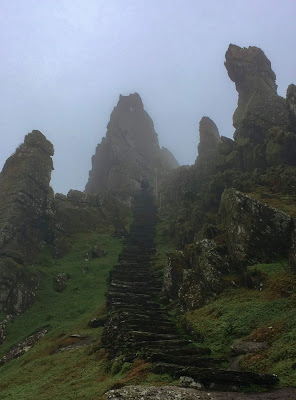 |
| Climbing "The Way Of Christ" |
As we climbed ever higher, the fog thickened even more. It was the beginning of August and the end of the Puffin season. The Skellig Michael guide told us we may see a few Puffin stragglers still hanging around the top of the island, but we would never have been able to have seen them through the dense fog. We came to a lush green meadow called "Christ's Saddle," which was an excellent place to rest and catch your breath before the hike to the monastery. Here there is another ancient and more treachours path that leads down to the ocean carved by the monks, but it is fenced off to visitors.
Christ's Saddle is the only flat, fertile land in the centre of the island and is about 3 acres in size. The monks of Skellig Micheal used this place to farm, and archeologists have dug up this area and found traces of medieval crop farming.
The steepest part of the climb up to the top of the Skellig is from Christ's Saddle, and it is aptly called "The Way Of Christ." Here there is nothing to hold onto as you ascend the final steep steps up to the hermitage at the top of the rock.
 |
| Monastery Gates |
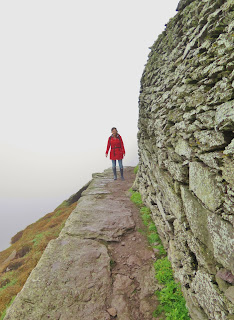 Finally, you reach a flat spot along a high wall that holds up the inner sanctum of the monastery's garden. The feeling of excitement is almost palatable at this point, and you walk through the centuries-old gate crossing the threshold into the sacred space.
Finally, you reach a flat spot along a high wall that holds up the inner sanctum of the monastery's garden. The feeling of excitement is almost palatable at this point, and you walk through the centuries-old gate crossing the threshold into the sacred space.A Skellig Michael guide awaits you in amongst the structures at the top and explains to your group how the monks lived here at this remote location for hundreds of years. The monastery was said to have been founded by Saint Fionán sometime in the fifth century. Saint Fionán (or Finian in English) was said to have been born in 470 CE and died of the plague in 549 in the Boyne Valley.
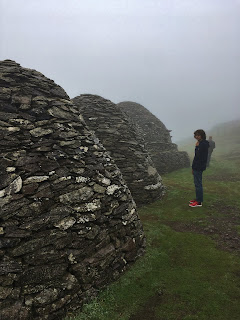 |
| Beehive Huts |
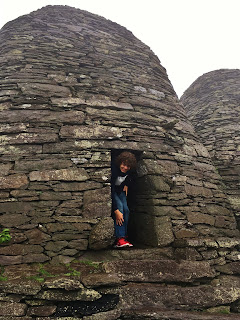 |
| Exploring The Monk's Cells |
 |
| Oratory On The Terrace |
At the monastery, there are six intact clochán or beehive huts and remains of several more. These structures are where the monks lived on the island and are built by a dry stone technique called corbelling, where no mortar is used to produce the shelter. Considering that these huts are probably close to a thousand years old and they were completely dry and cozy inside, I would say these monks knew what they were doing!
There are also two oratories here on Skellig Michael. Their shape is built like a square to fit in more monks for worship, which occurred several times a day.
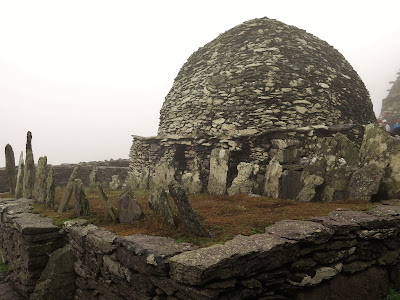 |
| Graves On Skellig Michael |
There is an evocative little cemetery on Skellig Michael with hand-carved stone crosses to mark the unnamed graves of the monks who died here. How many died from disease, Viking raids, or just slipping off the rocks? Experts believe that no more than 12 monks at a time lived here with one Abbot. I don't believe that. I bet there were more monks stuffed in those clocháns then we think; how else would you stay warm on those freezing winter nights?
The monastery was more advanced than we think it could have been. There were cisterns to catch rainwater, terraces with vegetable gardens or perhaps where some livestock was kept. Besides the two oratories on the grounds, there is a Medieval chapel that has a window looking out over to the mainland. There is a grave at the chapel of two small children here dating from the 1800s; the lighthouse keeper's children.
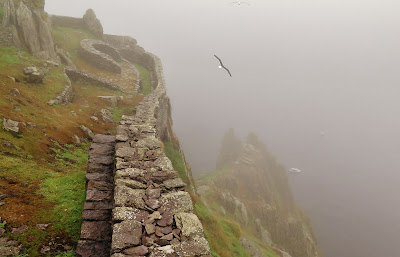 |
| View From The Terrace On Skellig Michael |
 |
| Climbing Back Down Skellig Michael |
Raids by Vikings became a regular occurrence at Skellig Michael by the 9th & 10th centuries. The monks were either murdered or taken as slaves by the Norsemen. Also, around this time, the Christian church was changing and wanted more control over remote outposts such as Skellig Michael. The monastery was abandoned by the 12th century and moved to Ballinskelligs, where an abbey was built.
The average time for tourists on Skellig Michael is three hours; 45 minutes to walk up the 618 steps, 45 minutes to explore the monastery and 30 minutes to walk back down to the boat dock. Walking down the staircase proved more challenging than climbing up them. Wobbly legs on slippery steps along the edges of cliffs is a sure way to get your adrenaline pumping!
 |
| Gannets On Little Skellig |
But the adventure isn't over after you get back on your boat! The captain takes you around Little Skellig Island, which is home to the most significant colonies of Northern Gannets in Ireland; 23,000 nesting pairs live here. These beautiful birds are graceful, loud and cover the island of Little Skellig in guano, so it appears white every summer and then returns back to black rock as the winter rains and ocean waves wash it clean again.
Once safely back at Portmagee, the contrast of our modern world compared to the Christian monk's simple existence on Skellig Micheal seemed almost incomprehensible. The achingly raw beauty of this island contrasts the harsh environment the monks needed to endure to survive in. It makes you realize that as the Dark Ages gripped the rest of Europe, the flame of knowledge and devotion burned bright on this tiny rock on the edge of the known world tended by a few fearless men who believed in God's beauty so ancient and so new.
Follow me on FACEBOOK, INSTAGRAM and BLOGLOVIN' for daily photos and updates! #slowtravel🐌 #dulgomall



